Data-Driven Health Assessment in Flight Control System
Abstract
:1. Introduction
2. Literature Review
3. Health Assessment Model and Comprehensive Health Index
3.1. Health Assessment Model
- (1)
- Pitch channel: steering column to elevator transmission coefficient.
- (2)
- Rolling channel: transmission coefficient from steering wheel to aileron.
- (3)
- Yaw channel: pedal to rudder transmission coefficient.
3.2. Comprehensive Health Index
4. Health Assessment Method
4.1. Fuzzy Comprehensive Evaluation
4.2. Weight Assignment Based on Rough Sets Reduction Algorithm
4.3. Relative Deterioration Degree
5. Certain Type Aircraft Flight Control System Health Assessment
5.1. Health Assessment for a Single Flight
5.2. Health Assessment for 60 Flights
5.3. Discussions
6. Conclusions
- (1)
- The calculation results are close to the actual operating condition, which proves that the model is suitable for the flight control system’s health assessment.
- (2)
- For the weight assignment of each level of the assessment model, the rough sets reduction is introduced to eliminate the subjective factors’ influence and overcome the defects based on expert experience.
- (3)
- The membership classification error can be avoided by membership value determination method based on the relative deterioration degree, which makes the evaluation matrix more accurate.
Author Contributions
Funding
Conflicts of Interest
References
- Fox, J.J.; Glass, B.J. Impact of integrated vehicle health management (IVHM) technologies on ground operations for reusable launch vehicles (RLVs) and Spacecraft. IEEE Aerosp. Conf. 2000, 2, 179–186. [Google Scholar]
- Bailey, R.; McSharry, M. K-1 Integrated Vehicle Health Management System: Design for Operational Efficiency. Proc. IEEE Aerosp. Conf. 2000, 4, 323–327. [Google Scholar]
- Yedavalli, R.K.; Belapurkar, R.K. Application of wireless sensor networks to aircraft control and health management systems. J. Control Theory Appl. 2011, 9, 28–33. [Google Scholar] [CrossRef]
- Donald, L.S. An overview of the NASA aviation safety program propulsion health monitoring element. In Proceedings of the 36th AIAA/ASME/SAE/ASEE Joint Propulsion Conference and Exhibit, Huntsville, AL, USA, 16 July 2000. [Google Scholar]
- Wu, M.X. Study of Health Simulation and Evaluation Technology for Vehicle’s Control System. Master’s Thesis, National University of Defense Technology, Changsha, China, 2012. [Google Scholar]
- Garcia, E.A.; Frank, P.M. On the relationship between observer and parameter identification based approaches to fault detection. Proc. IFAC World Congr. 2001, 29, 25–29. [Google Scholar]
- Yi, X.J. Health Estimation and Prognostics for Complex Electromechanical System Based on Semi-Quantitative Information. Master’s Thesis, ChangChun University of Technology, Changchun, China, 2017. [Google Scholar]
- Sun, K. Complex Electromechanical System State Analysis Method Based on System Map. Master’s Thesis, Northwestern Polytechnical University, Xi’an, China, 2016. [Google Scholar]
- Shu, J.T.; Jin, L.; Lin, L. Fuzzy Support Vector Regression-Based Link Quality Prediction Model for Wireless Sensor Networks. J. Comput. Res. Dev. 2015, 52, 1842–1851. [Google Scholar]
- Khedher, L.; Ramirez, J.; Gorriz, J.M. Early diagnosis of Alzheimer’s disease based on partial least squares, principal component analysis and support vector machine using segmented MRI images. Neurocomputing 2015, 151, 139–150. [Google Scholar] [CrossRef]
- Jiang, Z.N.; Zuo, H.F.; Li, L.R. Research on Fault Prediction Method of Trailing Edge Flap Position Sensor Failure. Aeronaut. Comput. Tech. 2018, 2, 75–78. [Google Scholar]
- Chen, Y.C.; Yang, W. Fly-by-wire Flight Control System State Monitoring and Health Management Base on Bayesian Decision. Comput. Meas. Control 2012, 6, 1449–1451. [Google Scholar]
- Cui, J.G.; Lin, Z.L.; Lv, R. Comprehensive assessment method of aircraft health status based on fuzzy fray clustering and combination weighting. Acta Aeronaut. Astronaut. Sin. 2014, 35, 764–772. [Google Scholar]
- Yang, Y.; Fu, G.C.; Wan, B. Component storage reliability evaluation method based on multi-performance parameters degradation analysis. In Proceedings of the 2011 Prognostics and System Health Management Conference, Washington, DC, USA, 23–25 May 2011. [Google Scholar]
- Shen, F.; Chen, C.; Yan, R. Bearing fault diagnosis transfer learning classification. In Proceedings of the Prognostics and System Health Management Conference 2015, Beijing, China, 21–23 October 2015; pp. 1–6. [Google Scholar]
- Zhang, K.F.; Guo, J.; Xiao, Z.H. Research on state evaluation method of transformer based on fusion of fuzzy comprehensive evaluation and improved D-S evidence theory. Wuhan Univ. J. Eng. Sci. 2016, 2, 279–284. [Google Scholar]
- Xu, H.L.; Peng, L.Y.; Wang, S.P. Research on Weight Allocation Method of Operation Quality Evaluation Indicator of Power Communication Network. Electr. Power Inf. Commun. Technol. 2019, 17, 45–51. [Google Scholar]
- Huang, B.Q.; He, Y.; Wang, T.Y. Fuzzy synthetic evaluation of the operational status of offshore direct-drive wind turbines. J. Tsinghua Univ. Sci. Technol. 2015, 55, 543–549. [Google Scholar]
- Kalgren, P.W.; Byington, C.S.; Roemer, M.J.; Watson, M.J.; Defining, P.H.M. A Lexical Evolution of Maintenance and Logistics. In Proceedings of the 2006 IEEE Autotestcon, Anaheim, CA, USA, 18–21 September 2006; pp. 353–358. [Google Scholar]
- Li, Q.; Wang, Y.; Zhang, K.; Cheng, Z.; Tao, Z. Life-Cycle Performance Assessment and Distress Prediction of Subgrade Based on an Analytic Hierarchy Process and the PSO–LSSVM Model. Appl. Sci. 2020, 10, 7529. [Google Scholar] [CrossRef]

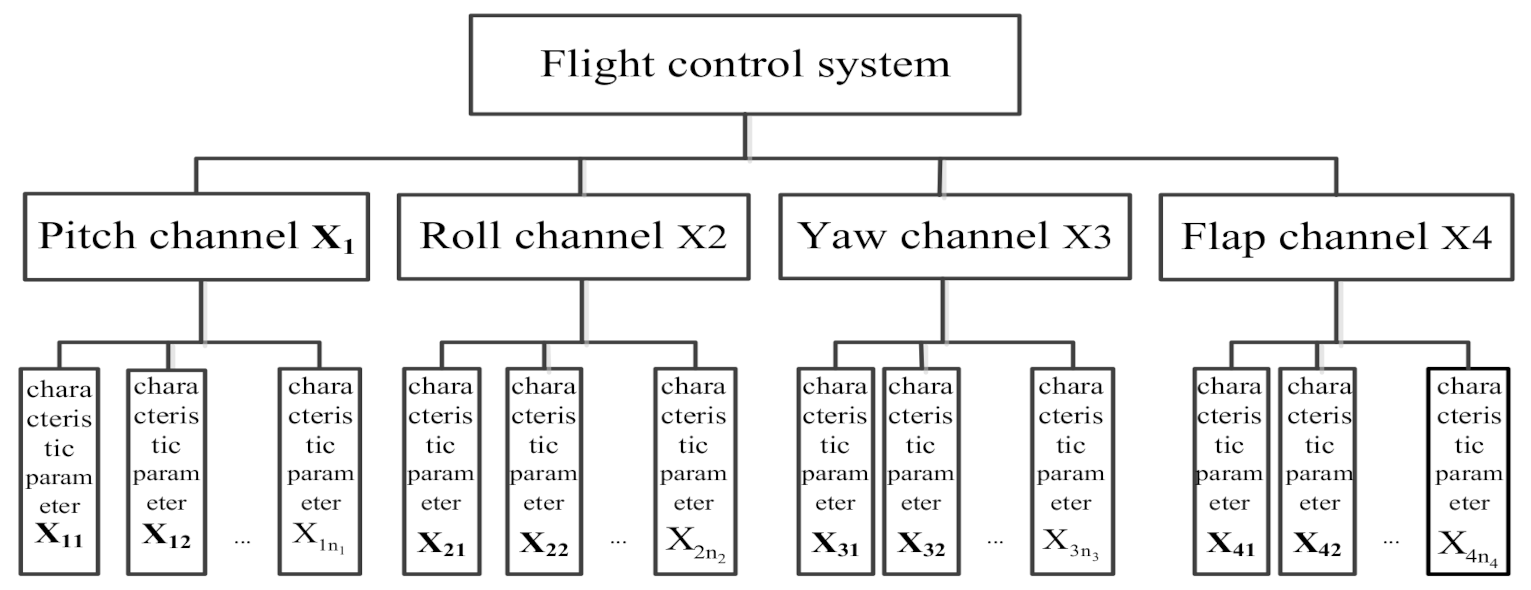


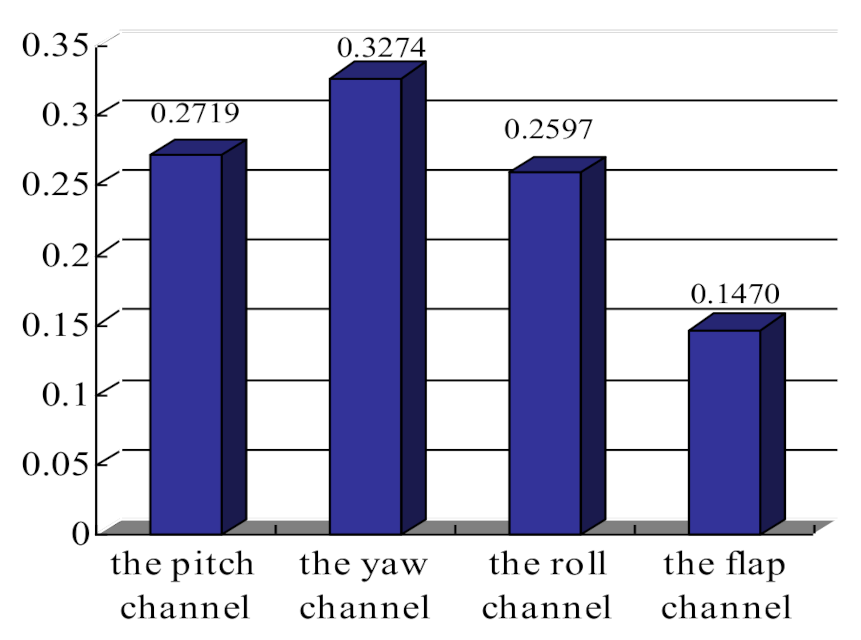
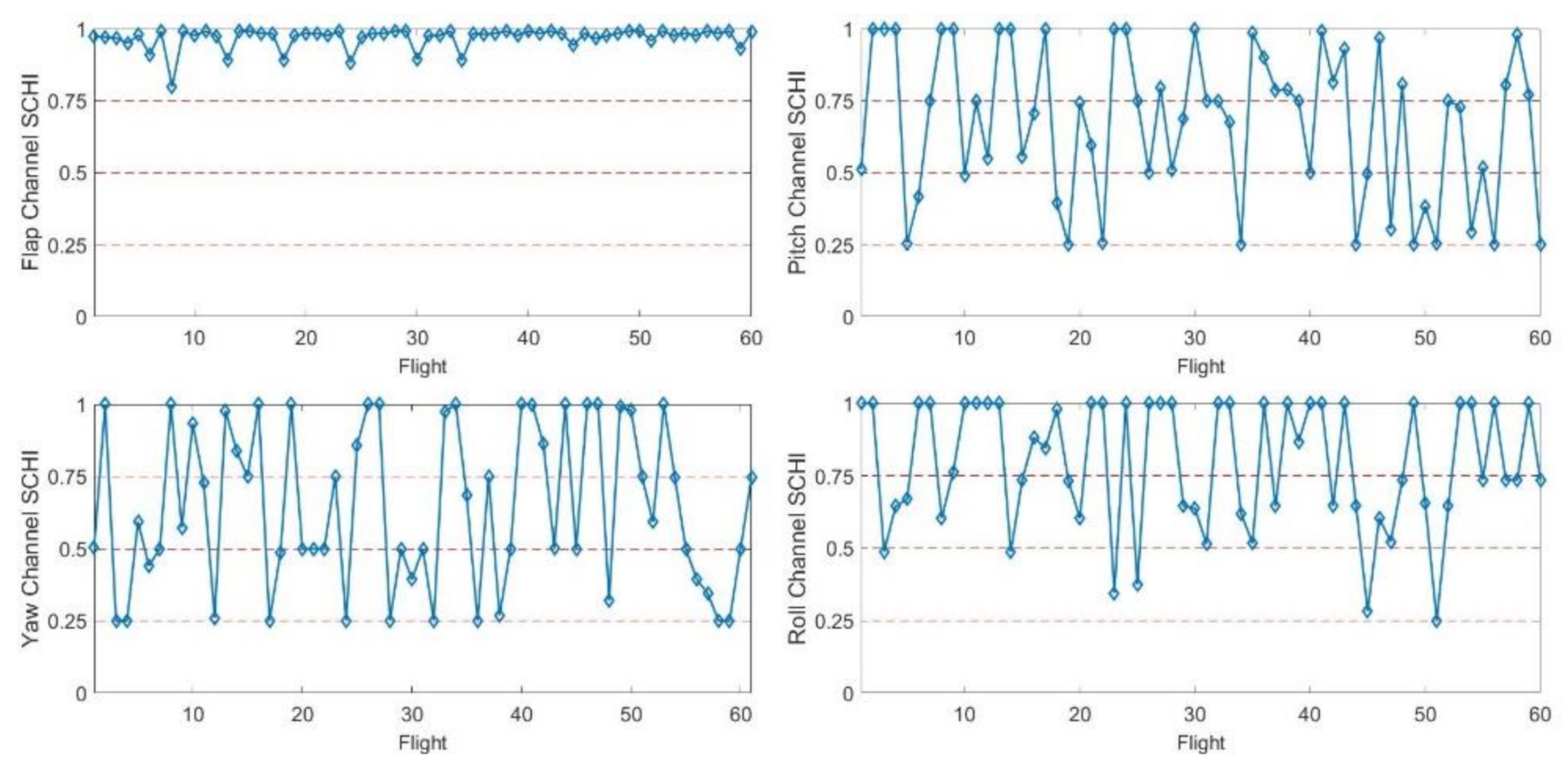
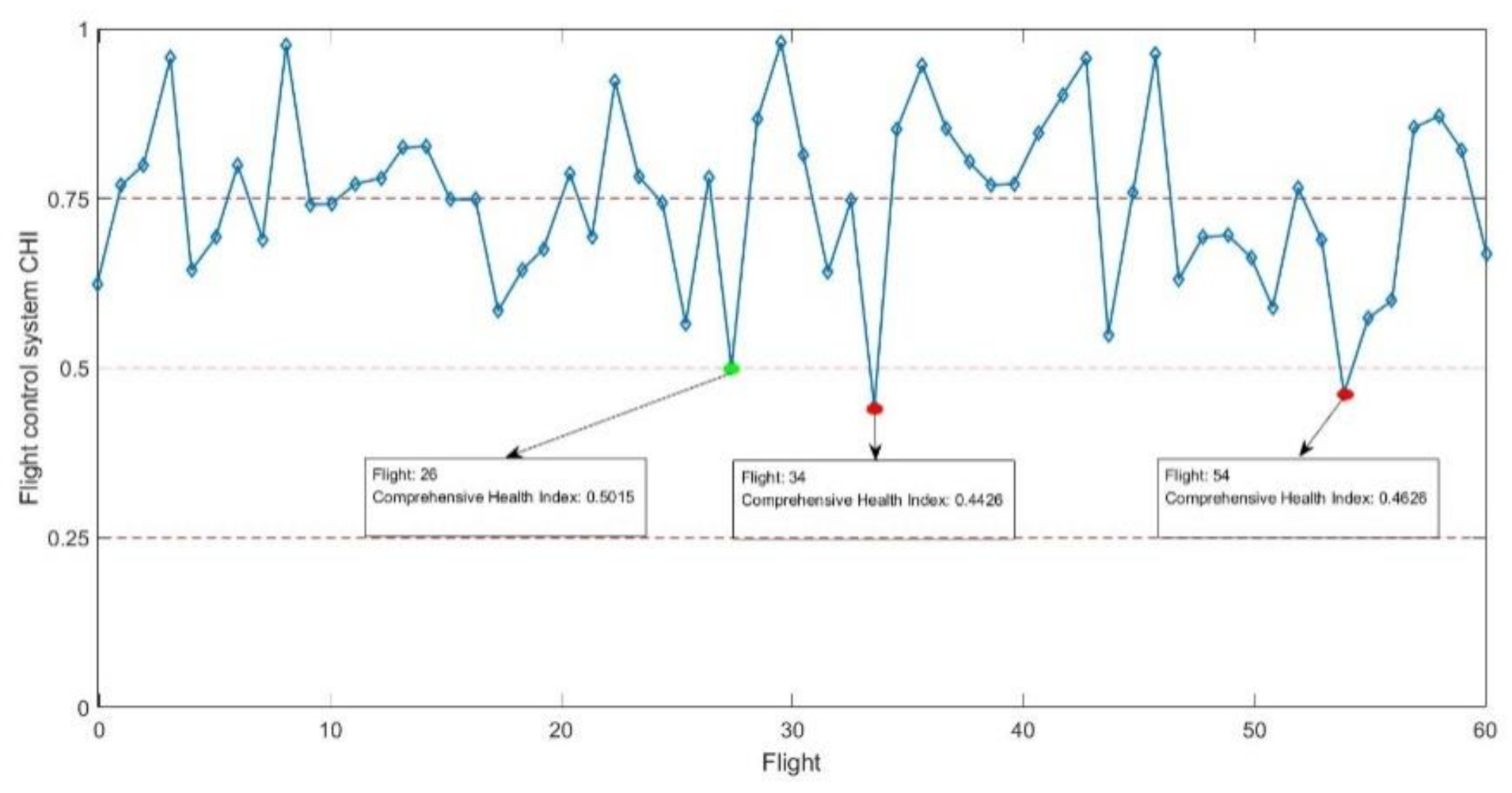
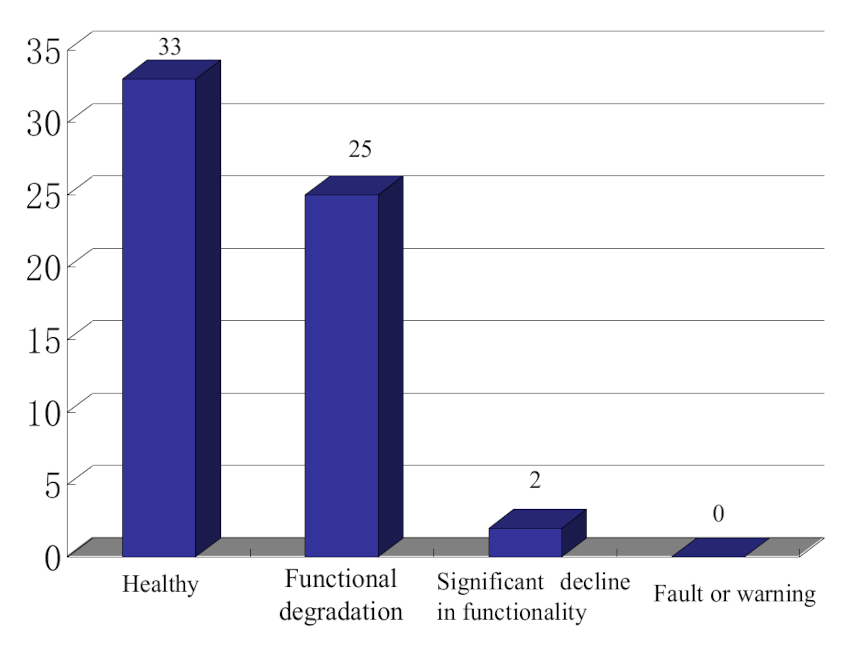
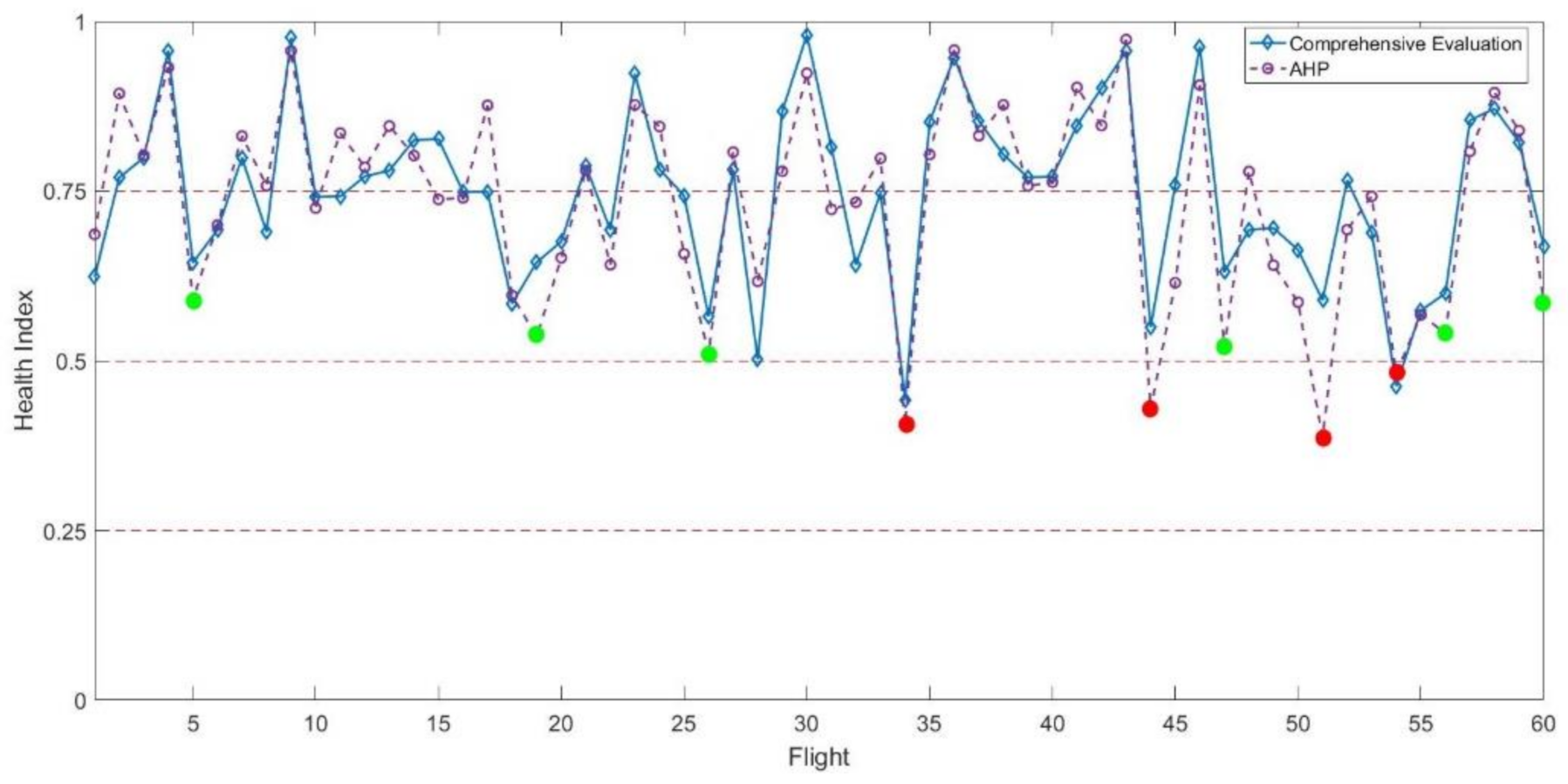
| Name | Failure Mode | Reason of Failure | Influence on System | Influence Degree |
|---|---|---|---|---|
| Steering wheel | stuck | Bolts are over tightened. | Aileron stuck | II |
| Steering column | assembly stuck | Bolts are over tightened, rotating bearing is dry and worn. | Elevator stuck | II |
| Rocker | Component disconnected | Connector break | Flight control system failure | I |
| Tie rod | Tie rod break | Cracks and scratches on tie rod pipes | Main control system failure | I |
| Name | Failure Mode | Reason of Failure | Influence on System | Influence Degree |
|---|---|---|---|---|
| Transmission components | Flaps are not synchronized on both sides | Transmission components fracture | Flaps’ retraction stops | III |
| Transmission components stuck | Spline or cross joint stuck | Flaps cannot be retracted | III | |
| Actuator | Actuator transmission failure or stuck | Gears are worn | Transmission components are stuck and flaps cannot be retracted | III |
| Flap position signal mechanism | Flap position signal mechanism does not work | Circuit is blocked or the switch is in poor contact | Flaps cannot be retracted | III |
| Fulcrum bearing of flap assembly | Transmission components deform and become stuck | Support shell is broken | Transmission component is stuck and the flaps cannot be retracted | III |
| Function Parameters | Value |
|---|---|
| 2229 | |
| 80.566 | |
| 1900 | |
| 2185 |
| Characteristic Parameters | ||||
|---|---|---|---|---|
| pitch channel’s transfer coefficient | 0.2331 | 0.1113 | 0.1276 | 0.1575 |
| yaw channel’s transfer coefficient | 2.7778 | 0.2445 | 0.3074 | 0.3758 |
| roll channel’s left transfer coefficient | -0.1840 | -0.4146 | -0.2335 | -0.1911 |
| CHI | Health State |
|---|---|
| 0.75–1 | Healthy |
| 0.5–0.75 | Functional degradation |
| 0.25–0.5 | Significant decline in functionality |
| 0.0–0.25 | Fault or warning |
| Flights | Channel | SCHI |
|---|---|---|
| 26 | flap channel | 0.9127 |
| pitch channel | 0.5000 | |
| yaw channel | 0.3933 | |
| roll channel | 0.3449 | |
| 34 | flap channel | 0.7883 |
| pitch channel | 0.2500 | |
| yaw channel | 0.2687 | |
| roll channel | 0.5138 | |
| 54 | flap channel | 0.9766 |
| pitch channel | 02946 | |
| yaw channel | 0.2500 | |
| roll channel | 0.6456 |
| Flights | SCHI of Pitch Channel | System CHI by the Proposed Method | System CHI byAHP |
|---|---|---|---|
| 5 | 0.5548 | 0.6442 | 0.5896 |
| 19 | 0.5310 | 0.6755 | 0.5353 |
| 26 | 0.5000 | 0.5015 | 0.5106 |
| 34 | 0.2500 | 0.4426 | 0.4060 |
| 44 | 0.5400 | 0.7592 | 0.4275 |
| 47 | 0.5909 | 0.6927 | 0.5194 |
| 51 | 0.5890 | 0.7659 | 0.3876 |
| 54 | 0.2946 | 0.4626 | 0.4813 |
Publisher’s Note: MDPI stays neutral with regard to jurisdictional claims in published maps and institutional affiliations. |
© 2020 by the authors. Licensee MDPI, Basel, Switzerland. This article is an open access article distributed under the terms and conditions of the Creative Commons Attribution (CC BY) license (http://creativecommons.org/licenses/by/4.0/).
Share and Cite
Chen, J.; Zhao, Y.; Wu, C.; Xu, Q. Data-Driven Health Assessment in Flight Control System. Appl. Sci. 2020, 10, 8370. https://doi.org/10.3390/app10238370
Chen J, Zhao Y, Wu C, Xu Q. Data-Driven Health Assessment in Flight Control System. Applied Sciences. 2020; 10(23):8370. https://doi.org/10.3390/app10238370
Chicago/Turabian StyleChen, Jie, Yuyang Zhao, Chentao Wu, and Qingshan Xu. 2020. "Data-Driven Health Assessment in Flight Control System" Applied Sciences 10, no. 23: 8370. https://doi.org/10.3390/app10238370
APA StyleChen, J., Zhao, Y., Wu, C., & Xu, Q. (2020). Data-Driven Health Assessment in Flight Control System. Applied Sciences, 10(23), 8370. https://doi.org/10.3390/app10238370




